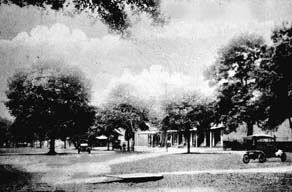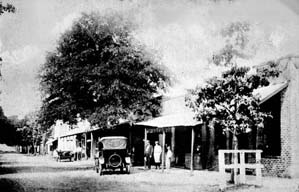PREFACE
In
compiling the History of Waldo and the surrounding area, there was no
single source for information. Many books had references, but there
would only be a paragraph or a sentence in each. The next step was
trying to contact older people who could relate what they know or
information they have saved about the settlement of the area.
This
was very productive since many people had information and
pictures. It was a challenge to gather the bits and pieces
and assemble them in one place. People in the Waldo area have been most
cooperative in supplying what they could and suggesting others who may
have additional input.
Bette
DeSha wrote a small book in which she related interviews
with local residents. It was an interesting collection of her efforts.
Somewhat like a diary of her work. She generously gave permission to
use any part of it toward writing a more complete history.
Some
of the early Black Heritage of Florida has been adapted from a
pamphlet Florida's Black Heritage by
the Florida Department of State.
Black
Americans have played a significant role in Florida's
history. It has woven a vibrant pattern through the fabric of
history, from the time that blacks participated in the early
exploration of Florida to the 1990's, when a black person became Chief
Justice of the State Supreme Court.
Some
may think it is reaching too far back in relating the settlement of St.
Augustine, but there is a continuity of events that lead to Waldo
existing where it is now located.
SAINT
AUGUSTINE
In
1567 the mission work by the Jesuits was started. This period of work
lasted for five years, then they were wiped out by uprisings. The
Franciscans arrived in St. Augustine in 1573. They worked hard to
develop the missions across North Florida and reached the peak of their
works in 1675. They built thirty-four missions in that period of time.
During the early 1700's, the English hired their Indian allies to
destroy the missions.
In
1675, a Chisia (Yuchi) woman escaped from slavery in Carolina and
reported that English men were teaching the Chichinecoa and Westos
tribes to Attack Florida and destroy the Timucua and Apalache
Indians.
Black
people participated in the early 16th century Spanish
explorations and were involved in the establishment of St. Augustine in
1565. In the 17th and 18th centuries African born slaves
escaped from English plantations in Georgia and South Carolina to seek
asylum in Spanish Florida. Slavery laws were less
harsh in Florida. The Spanish slave system offered two routes
out of slavery: conversion to Roman Catholicism and military service to
the Spanish government. As early as 1683, a company of black
and mulatto militia was formed in St. Augustine. In 1738,
Spain established a fortified town specifically for runaway slaves
under the command of black captain Francisco Menendez. The
resulting Gracia Real de Santa Teresa de Mose (Fort Mose) was the first
legally sanctioned free black town in the United States. The
fort was occupied until the end of the French and Indian Wars in 1763
when Florida was turned over to the British and the Spanish were forced
to evacuate. A number of the black people left
with the Spaniards for Cuba.
Spain
regained control of Florida at the end of the American Revolution in
1783, another fort, at Prospect Bluff, a strategic point on the
Apalachicola River, became the center of contention between the United
States and Spain. The British had abandoned "the
Negro fort ," as it was then known, to the Indians and former
slaves. In 1816, American gunboats assaulted the fort, firing
heated cannon balls, which struck the magazine, igniting the
gunpowder. The resulting explosion destroyed the fort and
killed many occupants.
Unable
to maintain effective control over the area, Spain ceded Florida to the
United States in 1821, it became an American slave territory.
Spain received no compensation for the Florida Territory.
England
was late in her efforts to explore and settle other lands, they did
very little exploration but rather moved in on the lands opened by
others. The Colonies of North Carolina, South Carolina, Georgia and
Alabama, were given as a Proprietorship to seven Lords from England. It
was granted perpetually for their use, to govern, build cities, conduct
trade and generally act as a possession of their own. Charles II of
England made this grant in the year 1663.
Through
the mismanagement of the Lords and abuse of power, the people
complained to the King , asking that he remove the Lords. The King said
that it could only be solved if the Lords would sell out their shares.
Five of the Lords sold out, Lord Greystone kept his share in North
Carolina and Lord Anthony Ashley kept his share in South Carolina.
Lord
Ashley arranged with Col. James Moore to assemble an army of Creek
Indians of Georgia and other renegades from South Carolina, to go into
North Florida to destroy the missions. They were completely destroyed
by 1704. This brought the mission era to an end. The Indians who were
not killed in the battles, were captured and sold into slavery to the
Plantation owners in the Caribbean Islands.
| The
path used by the missionaries to walk or ride horseback from one
mission Settlement to another was at the time named the path. This path
is directly involved with the history of Waldo, since it ran through
the town. It extended from St. Augustine to Pensacola. It was a
difficult way to travel through swamps, crossing rivers and heavy
underbrush in wooded areas. This path is an important part of
the History of Waldo.It eventually became Bellamy Road. |
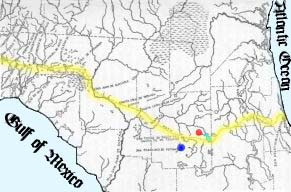
1675 Map of the Path,
222KB
|
INDIGENOUS
PEOPLES
The
Timicuan People lived in a large area from north of present
Jacksonville, south to the present Ocala region. They were a peaceful
people, living in villages. They hunted for meat and planted crops
which they stored for winter for the whole village. There
were five tribes.
It
is important to include their history with that of Waldo because they
lived in this area where settlers arrived in the 1500's,
until they were wiped out in the middle of the 18th century.
In 1573 Pedro Menendez de Aviles, founder and governor of the colony at
St. Augustine, arranged with the Franciscan missionary friars to work
among the Timucua. An alphabet was developed for them and
they learned to read and write. Their population was
decreased by diseases of the white man, and by battles and
capture by invading Seminole Indians from Georgia
hired by the English.
They
wore very few clothes. The men were tall and
stately, dressed in loin cloth, a headdress of feathers, and
wore jewelry of shells, pearls, and animal teeth. The women
were attractive, smaller than the men, making skirts from
vines. They were all hard workers for survival and with so
many lakes and rivers were good swimmers.
|
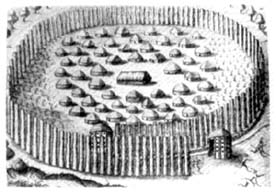
|
Fortified
Indian Village. A fence made of thick round poles, some 12
feet high, surrounded the village. Two guard stations with attendant
warriors protected the main, spiral-like entrance. Most
villages were located by streams which were redirected to flow by the
central entrance. In the center of the village was a large assembly
area around which could be found the huts of the Chief and principal
elders. |
|
| The
Timucuan Indians hunted alligators by thrusting large poles into the
alligator's open mouth. They then turned the impaled creature
on his back and with clubs and arrows pounded and pierced his soft
stomach. Alligator meat is used to this day. |
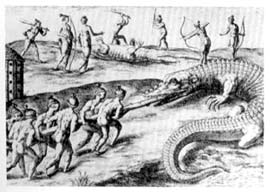
|
|
In
1750 the Creek Nation Conference took place in Georgia. Part
of the Nation was discontented and broke from the main group. They
became the Seminoles. This warlike group moved into North
Florida starting the Seminole Wars. They couldn't live peacefully with
their own people and were not tolerant of white settlers. As
a result there were several Seminole Wars against the settlers and
villages.
The
Second Seminole War (1835-1842) disrupted Florida's territorial
years. During these wars, people of Waldo took refuge in Ft.
Harlee, three miles away from the town. Although many black
people had gained their freedom by escaping to Florida, many others had
become slaves of the Seminoles. Their servitude was benign,
however, as the Indians allowed black people to live in separate
villages and demanded only 1/3 of their crops. The black
people were expert cultivators and provided food for the
Seminoles. In addition, the former slaves, who spoke both the
Indian languages and English, were valuable interpreters for the
Seminoles during treaty negotiations. They sometimes fought
with the Indians against the U.S.Army.
Before
Florida was taken from the Spanish, in order to try to stop
the Indian uprisings in West Florda, General Andrew Jackson drove the
Seminoles into Alachua County in 1818.
As
the fortunes of war turned against the Seminoles, some black people
changed their loyalties and served as guides and interpreters for the
U.S.Army. Many accompanied their 'masters' to the
Indian territory at the end of the war, when the Seminoles
were forced to give up their lands in Florida. Descendants
of these 'Black Seminoles' still live in Oklahoma and Texas.
Others were returned to or brought back by their former white
owners. The last remnant of the Seminoles retreated to the
Everglades in 1937, where there are a few still living.
BELLAMY
STATION
The
Sparkman family came into Florida in 1819, then moved into Alachua
County in the 1920's to settle along the west side of Lake Alto. A
village developed on the NW shore of Lake Alto as more settlers moved
into the area. It was located on a corner of the Sparkman Plantation.
This village was burned by the invading Seminoles but was rebuilt.
The
site of the new capitol of Florida, Tallahassee, was chosen
by John Lee Williams of Pensacola and Dr. W.H.Simmons of St.
Augustine at a meeting with Governor William P. Duval in March 1823. By
November 1824 a one room log house was erected for Legislative Council
meetings. Plans for a two story building were
approved in 1825. One year later one wing was completed
November 1826.
In
1845 Florida entered the Union as the twenty-seventh state.
Due
to the need for a better road across North Florida,on February 28,
1824 Congress authorized the building of a road from
Pensacola to St. Augustine, passing near Waldo. Col. John
Bellamy offered his slaves, wagons and teams for this project . The
road was to be constructed over the old path to make it passable for
wagons and other transportation. The segment of
road closest to the settlement was called Bellamy Road and the
settlement was named Bellamy Station in 1826.
According
to the account given by Bette DeSha in her book. East
Side of Eden, two of the main roads of Alachua
County were Bellamy Road and the Micanopy Trail which crossed at the
southeast corner of the Sparkman homestead. Bellamy Road ran
east almost parallel to the Bradford County line past a small
settlement called Louise which was named for Louise DeSha. .
It then curved South to border Bellamy Station. Several of
the streets merged at this point. The road then went south
along Lake Alto shore past the Franklin DeSha plantation, about two
miles south of Waldo bearing left to Earleton and on to Melrose.

Bellamy Road segment in
northern Alachua County |
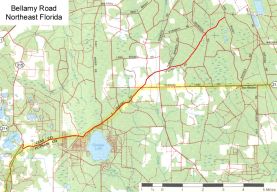
Existing Remnant of
Bellamy Road, 208KB
|
When
Bellamy Road was completed in 1826 it opened the interior across north
Florida to further settlement. The road was not much better
than a trail and extended about 600 miles from St.Augustine to
Pensacola. It was important for transporting cattle, timber,
cotton and other crops to ports where they were sent to northern
markets. New towns developed along its route.
In
1847, Peter Sparkman, son of William Sparkman, built a bridge over the
Santa Fe River, and by 1850, Bellamy Station had grown having two Main
Streets, Sparkman Street and Kennard St. named for local people.
CIVIL
WAR
One of the earliest
organized calvary units was the Second Florida Calvary which became
known as the famous Company H under Captain John Dickerson.
Many Waldo men were in this company.
In 1861 Florida's
population of about 141,000 people, roads were few and in rough
condition, Agriculture had been developed very little, there
were only a few hundred railways and a small amount of
industry. As a result Confederate Leaders withdrew troops from Florida
leaving it defenseless.
Later in the the war the
South was depending heavily on the cattle, hogs and salt to provide for
their army. By 1863 troops were sent to Florida to defend this supply
of food.
Courageous black slaves
who remained loyal to the families, helped the women grow
crops for the family which were abundant enough to have food left for
the Army. The whole household would work to supply
bandages and help the wounded. These black people in helping the women
to maintain the farms, gave courage to the families.
There were many smaller
battles with the major battle fought at Olustee. Many reenactments have
been staged at that site in commemoration. As a result of the
skirmishes much property was destroyed.
When the Civil War ended
April 9, 1865, the Union flag was raised over the Capitol Building in
Tallahassee, May 20, 1865. Many outposts were mustered out
gradually throughout the state. Soldiers were stacking their
arms and turning in military equipment at Camp Baker near
Waldo. All military units had surrendered by June 8, 1885. It
is said that the personal papers of Jefferson Davis were captured at
Waldo's railroad station built just a year before.
Men from the famous
Company H, Second Florida Calvary, who returned to their homes in the
Waldo area were:
W.H.Donaldson, Hicks,
Sparkman, James Sparkman, P.W.Sparkman, J.B. Strickland, Y Tillis, B.B.
Weeks, J.A.Weeks, S.S. Weeks and S.T.Weeks.
From Company B. the
following returned:
T.J. Branning,
D.L.Branning, Elmore Cook, Donaldson, H.Granger, J.A.Granger,
M.D.Granger, A.J.King, G.W.Sparkman, G.W. Sparkman. Kennard
and Raulerson were mustered out elsewhere.
After the war, the Carpetbaggers
and Scallywags moved into Waldo, these two groups created
much corruption. Multiple voting by individuals was
prevalent. Order was eventually restored.
The Confederate loss of
the war ushered in reconstruction when blacks and whites struggled with
the economic and social turmoil. Ratification of the 13th,
14th, and 125th amendments to the US constitution was vitally important
to the development of values, ideologies and institutions among the
Black people. The Bureau of Freedmen, Refugees and Abandoned
Lands created by an Act of Congress in 1865 to deal with the urgent
problems created by the sudden emancipation of four million slaves.
The American
Revolutionary Biennial Administration had designated the city of Waldo
as an official Centennial Community as of April 14, 1976.
THE STACKING OF ARMS
anniversary celebration was held May 19-20, 1987, in Waldo. There was a
commemoration service held at the Old Waldo Cemetery, Reenactment of
the Surrender was held in the town park. Reenactment camps had been set
up and were open to the Public.
WALDO
The region around Waldo
is a high area in Alachua County, it has been
considered since the first settlements to be a very healthful
environment in which to live. It is not noted for severe
weather like hurricanes and tornadoes. In 1879 an earthquake
shook up the area of North Florida from the epicenter at Palatka to
Cedar Key and north of Jacksonville. Again in 1886 there was
an earthquake which shook North Florida, Georgia and South
Carolina. There was little to no damage in the Waldo area.
One of the most
important areas of development in Florida after the Civil War was
education. Johathan Gibbs, Florida's only black
cabinet member during Reconstruction was appointed Secretary of State
in 1868 and later served as State Superintendent of Public
Instruction. He developed the state's first public school
system. This was a milestone as Black Americans had been
denied education during the years of slavery.
Waldo's first newspaper
was named the Florida Cracker.
Later a weekly
newspaper The Florida Advertizer, was
established by J.B.Johnson, owner and editor. He
was formerly of the Atlanta Constitution and the Troy
Enquirer. Mr. Johnson for five months in the winter was
employed as a teacher in the public school, when there was an average
attendance of 108. In the summer the school is run as a
private school, when the attendance was not so large.
Waldo's First
School was held in one room of a building erected on the
East End of the town park. Classes were held in the ground
floor of the two story wooden building along Main Street (Sparkman St),
it was established in 1869. Capt. John G Smith was the only
teacher. Teachers were paid according to the number and race
of their students. $50. per month for white students up to
$80. per month for black students. The school term lasted 3
months of the year, from sunup to sundown each day. By 1882, the school
was outgrown and a new one had to be built. In 1881, the land
for an expanded public school was donated by Hardy Raulerson.
Capt.J.B.Johnston was the first teacher in the new building.
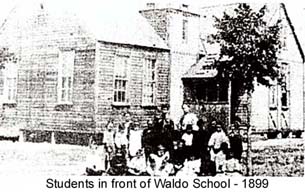 Alachua County
established the only county High School in Waldo in 1893, the first
class to graduate was in 1906. Alachua County
established the only county High School in Waldo in 1893, the first
class to graduate was in 1906.
Other cultural and
social institutions were also established. The rise of
independent black churches unfolded against a background of political
crisis, social adjustment, and vivid memories of the slave
experience. The churches were the centers of social and
political activities as well as religious life.
The Waldo House, built
in 1869, provided quarters for men who worked for the railroad, at $2.
per night. the Beckham House offered rooms at half the price.
In the 1870's Waldo was
advertised as a Winter Playground attracting Tourists who arrived by
railroad to vacation. There was an opera house which
presented plays, lunches served at the Waldo Hotel, baseball, and
cruises on the Lake Alto.
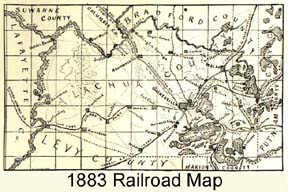 In
1883 a Chicago Times reporter, Barbour, came to Waldo on an
extended assignment for the Railroad, to prepare a series on tourism
for North Florida. He stayed with the President of the
Railroad. In
1883 a Chicago Times reporter, Barbour, came to Waldo on an
extended assignment for the Railroad, to prepare a series on tourism
for North Florida. He stayed with the President of the
Railroad.
There were thriving
businesses which have been listed on a separate page with names of the
owners in most instances. The business section of town faced the line
of the railroad.
Public notice was given
December 16, 1875 of a meeting to be held January 15, 1876 to
considering incorporation of the town. A meeting was held to elect
officers and organize a Municipal Government and boundaries were set
for the town. There were approximately six miles of streets, and one
fourth of the tom was planted in oranges.
The following is an
account of the boundaries of the town, according to the DeSha account.
Starting
at the NW corner of SW Quarter (114)of Section fourteen (14)Township
eight (8) Rangetwenty-one (21) East and running due south one and one
fourth (1 1/4)miles to SW quarter (114)of Section23 Township 8 Range
21. Then east one and one quarter (1 1/4) miles to northeast corner of
northwestquarter (1/4) of southwest quarter (114) of Section Thirteen
(13) Township eight (8) range 20 then west one and one quarter (1 1/4)
miles to starting point.
The first Council: Dr. J.M.Perry, R.B.Weeks, Henry
Jenkins, T.M. Cauthen, M.S. Cheeves,
L.Howe, Joe Lynn, W.C. Cheeves, T.B. Thus,
Mayor - W.T. Cheeves, Marshall Hl. Raulerson - Clerk -
Treasurer.
Newly freed blacks began
to establish homes and businesses in the white communities.
By the 1880's this created great tension which led to the beginnings of
segregation between the blacks and whites. In 1887,
Eatonsville became the first all black incorporated city in
Florida. A more common form of segregation was the
restriction of blacks to a particular area of a community.
One of the earliest examples was Miami's 'Colored
town' which was designated in 1896. It is now
called Overtown one of the oldest neighborhoods in Miami.
Florida's Black
Americans have contributed richly to the development of our state and
Nation.
Newly freed blacks began
to establish homes and businesses in the white communities.
By the 1880's this created great tension which led to the beginnings of
segregation between the blacks and whites. In 1887,
Eatonsville became the first all black incorporated city in
Florida. A more common form of segregation was the
restriction of blacks to a particular area of a community.
One of the earliest examples was Miami's 'Colored
town' which was designated in 1896. It is now
called Overtown one of the oldest neighborhoods in Miami.
Other cultural and
social institutions were also established. The rise of
independent black churches unfolded against a background of political
crisis, social adjustment, and vivid memories of the slave
experience. The churches were the centers of social and
political activities as well as religious life.
A fire destroyed the
heart of the business area in 1893, but the residents quickly rebuilt,
only this time in brick. This was stated in Bettee DeSha's
book but no record of a fire can be found at this time.
The Florida
Advertiser was a weekly newspaper in Waldo in the
1880's. The publisher was W.B.Johnson and its editor and
proprietor was J.B.Johnson. The newspaper was in a constant
battle with the Railroad concerning the rundown condition of
the Station, and their disregard for the comfort and safety of the
passengers. The paper was sustained by advertising and
circulation.
In the
1870's Waldo was advertised as a Winter Playground attracting Tourists
who arrived by railroad to vacation. There was an opera house
which presented plays, lunches served at the Waldo Hotel,baseball, and
cruises on the Lake Alto
Scenes
of Waldo, circa 1900
From
Elliots Florida Encyclopedia 1900, land sold for $10-25. per
acre, the population was 800 PostMaster was S.J.Kennard and
the Mayor was S.J. Kennard, jr.
Waldo
is a quiet little city, with a country atmosphere. Located at the
junction of State Road 24 (Waldo Road) and US Route 301. Here you will
find lakes to fish, sail, and water-ski. There is a large
weekend flea market, some historic homes and several
antique shops.
WaldoHistory.com
is the work of Mary Louise Ashley Strohmier, who was responsible for
the content. She
died on 6 August 2005. Her obituary can be found at: http://ashleys.net/Louise/Obituary.htm
|

![]()







